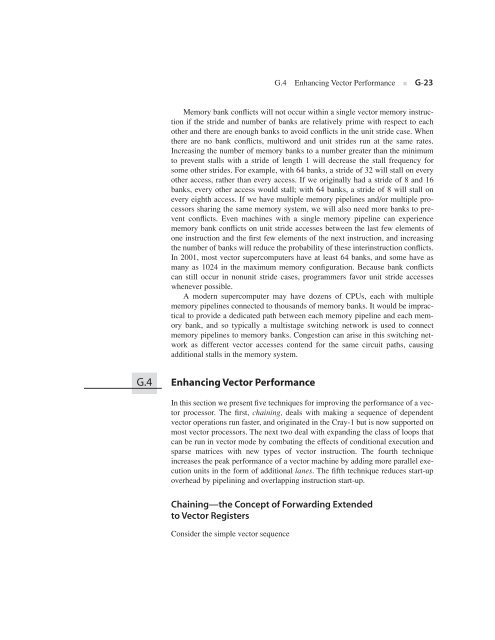Appendix G - Clemson University
Appendix G - Clemson University
Appendix G - Clemson University
Create successful ePaper yourself
Turn your PDF publications into a flip-book with our unique Google optimized e-Paper software.
G.4 Enhancing Vector Performance ■ G-23<br />
Memory bank conflicts will not occur within a single vector memory instruction<br />
if the stride and number of banks are relatively prime with respect to each<br />
other and there are enough banks to avoid conflicts in the unit stride case. When<br />
there are no bank conflicts, multiword and unit strides run at the same rates.<br />
Increasing the number of memory banks to a number greater than the minimum<br />
to prevent stalls with a stride of length 1 will decrease the stall frequency for<br />
some other strides. For example, with 64 banks, a stride of 32 will stall on every<br />
other access, rather than every access. If we originally had a stride of 8 and 16<br />
banks, every other access would stall; with 64 banks, a stride of 8 will stall on<br />
every eighth access. If we have multiple memory pipelines and/or multiple processors<br />
sharing the same memory system, we will also need more banks to prevent<br />
conflicts. Even machines with a single memory pipeline can experience<br />
memory bank conflicts on unit stride accesses between the last few elements of<br />
one instruction and the first few elements of the next instruction, and increasing<br />
the number of banks will reduce the probability of these interinstruction conflicts.<br />
In 2001, most vector supercomputers have at least 64 banks, and some have as<br />
many as 1024 in the maximum memory configuration. Because bank conflicts<br />
can still occur in nonunit stride cases, programmers favor unit stride accesses<br />
whenever possible.<br />
A modern supercomputer may have dozens of CPUs, each with multiple<br />
memory pipelines connected to thousands of memory banks. It would be impractical<br />
to provide a dedicated path between each memory pipeline and each memory<br />
bank, and so typically a multistage switching network is used to connect<br />
memory pipelines to memory banks. Congestion can arise in this switching network<br />
as different vector accesses contend for the same circuit paths, causing<br />
additional stalls in the memory system.<br />
G.4 Enhancing Vector Performance<br />
In this section we present five techniques for improving the performance of a vector<br />
processor. The first, chaining, deals with making a sequence of dependent<br />
vector operations run faster, and originated in the Cray-1 but is now supported on<br />
most vector processors. The next two deal with expanding the class of loops that<br />
can be run in vector mode by combating the effects of conditional execution and<br />
sparse matrices with new types of vector instruction. The fourth technique<br />
increases the peak performance of a vector machine by adding more parallel execution<br />
units in the form of additional lanes. The fifth technique reduces start-up<br />
overhead by pipelining and overlapping instruction start-up.<br />
Chaining—the Concept of Forwarding Extended<br />
to Vector Registers<br />
Consider the simple vector sequence

















